Windows 10 Launches Worldwide
by Brett Howse on July 29, 2015 1:30 AM EST- Posted in
- Operating Systems
- Microsoft
- Windows 10
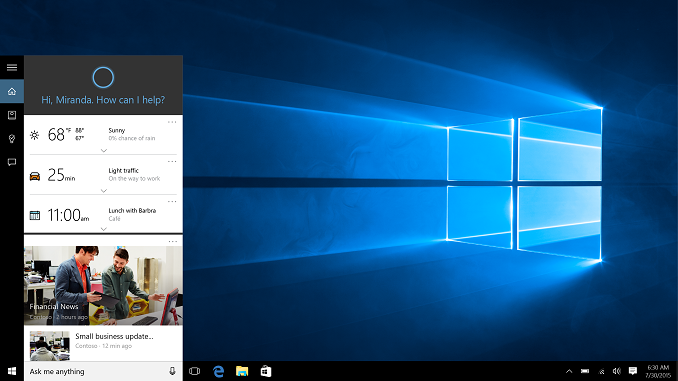
It has been a busy time in Redmond. Three hundred and two days ago, on September 30, 2014, Windows 10 was announced by Microsoft. The name, at the time, was a bit of a surprise, and Windows 10 was born out of the ashes of Windows 8.1. Over the last three hundred days, we have seen a pronounced change in how Microsoft develops software. Windows 8 was the crowning achievement of Steven Sinofsky, and his sudden departure from the Redmond company only weeks after Windows 8 shipped perhaps signaled that Microsoft knew out of the gate that Windows 8 would be controversial and difficult to adopt for their core user group. A new direction was necessary.
And so we have Windows 10. Separated from Windows 8 by more than just a number, it was also forged by a Microsoft who was more open about the development process than I can ever recall. The day after Windows 10 was announced, Microsoft opened up the Windows Insider program, to give anyone who wanted a look at the new take on Windows to give it a spin, and not only that, they could offer feedback and suggestions for apps and features. The changes made to Windows 10 over the last three hundred odd days, have been dramatic, which is a testament to how the new Microsoft takes and processes the huge amount of feedback it received.
Windows 10 Start Menu and Desktop in October 2014
The Windows Insider program was very successful. Very quickly the number of people who had signed up was over a million, and the last count that I saw was that there are over five million people in the Windows Insider program. The response has certainly been enthusiastic.
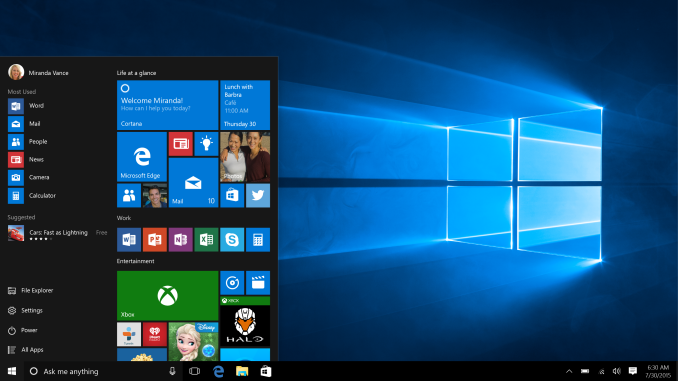 Windows 10 Start Menu and Desktop at release
Windows 10 Start Menu and Desktop at release
Of course it helps that the software being tested showed that Microsoft was listening well before the Insider Program even began. Windows 8’s biggest pain points, such as the Start Screen, full screen apps, and the Charms bar, were not going to be tweaked in this release, but completely done away with. Back was the Start Menu, back was windowed apps, and back was what made Windows, well, Windows. Where Windows 8 was promoted as touch-first, Windows 10 was created as productivity first, with the OS trying to assist you with things like Snap Assist rather than get in your way.
There is a lot of changes and features to go over, and in typical AnandTech style, we are going to provide as much information about each as we can. I wanted to ensure that we did the review with the final code, to ensure any of our tests would be accurate and real-world results. Hopefully the full review is worth the wait.
With Windows 10 being the first ever free upgrade, here is a quick look at what to expect if you signed up to get the upgrade on day one.
Windows 10 gains a personal assistant in Cortana. What originally launched on Windows Phone has been brought to the PC, and it can now work across all of your Windows devices. One of the key benefits of Windows 10 over Windows 8 is that features like Cortana are easily discoverable. Cortana now lives in a search box right beside the start button, and it can keep track of your travel plans, set up reminders, and perform searches for you.
Microsoft is also adding a new browser to Windows 10, with Microsoft Edge. Although based on Internet Explorer under the hood, huge chunks of code have been taken out to improve security, and the rendering and scripting engines have been optimized to make Edge one of the fastest browsers around. It adds support for new features like being able to markup web pages and share them, and Cortana is built in to provide contextual search results right in the page. It is a big step up from Internet Explorer in standards compliance, and while it’s not quite finished yet, Microsoft has promised to update it often through the Windows Store.
With Windows 8, Microsoft basically built a tablet operating system, and stuck the desktop inside of it. I actually quite liked the design when using Windows 8 with touch, but using it on a large screen desktop could be frustrating. Windows 10 is still designed for both systems, but they have added Continuum to Windows 10 to automatically prompt to switch from one mode to the other. Optimizing Windows for what you are doing is a much better approach than optimizing for what you’re not doing, and Continuum finally bridges the gap between desktop and tablet on one device.
Gaming is getting a big boost on Windows 10, with support for DirectX 12 which is the biggest change to their gaming APIs since DirectX 10 launched with Windows Vista way back in 2006. DirectX 12’s most important feature is likely its low-level API, which can provide much better performance in a lot of scenarios where developers had been CPU bound before. Graphics Processing Units are massively parallel devices, but could be bottlenecked by the API being CPU bound. DirectX 12 makes some big changes to the API to give the developers the chance to get around these bottlenecks, and the upcoming DirectX 12 games can add a level of detail that was unattainable before.
Gaming doesn’t stop there though. Windows 10 brings some other cool things to gaming on the PC. The built in Xbox app will support Game DVR, allowing you to record game sessions, edit them, and share them, all within the Xbox app. One of the coolest features coming is game streaming from an Xbox One to any Windows 10 PC, allowing you to use any PC or tablet as the display for the Xbox, as long as it is on the LAN. This isn’t new tech, but it will be built into every Windows 10 PC. Windows 10 is also going to offer cross-device gameplay, allowing you to play against people on Xbox One or Windows 10. Some games will even support starting a game on one device and finishing on the other.
The built in apps have all gotten major overhauls with Windows 10, and now work a lot better on a desktop but equally well on a touch device. Photos has gone from an almost unusable application on Windows 8 to a very nicely executed app in Windows 10. Mail has seen a huge change, and has taken cues from their purchase of Acompli, which had one of the best email apps on iOS. Maps has also gotten a big facelift, and it can sync information among all of your Windows devices. Xbox Music has been rebranded to Groove Music, and the movies app is now a movie player with the Windows Store being unified to include all purchases including movies and TV.
On the security side, Windows 10 brings a lot of features here as well. One I am very much looking forward to is Windows Hello, which will allow you to log in with supported facial recognition hardware, or fingerprint readers. Once logged in, Passport will be available as a service to allow authentication to external services, if they add support. This will leverage public-private key technology, so if a third party was able to obtain the database of passwords from a web service, they would just have your public key which is useless to them. I’ve said it before, and will say it again. Passwords have outlived their usefulness and any work to move this technology forward should be a huge benefit to everyone.
And these features are really just the tip of the iceberg, with far more available including virtual desktops, drop shadows, a new dark theme, and more. Windows 10 is a big step up from Windows 8, but also from those that hung back on Windows 7. With the free upgrade from Windows 7 or 8 being offered for a year, adoption should be strong, but time will tell. I have been running Windows 10 since October, and as my daily computer since January. It has been worth the wait.


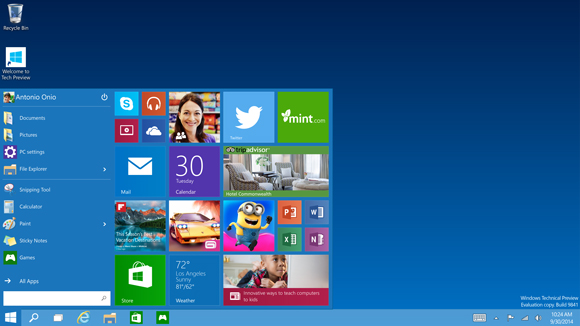
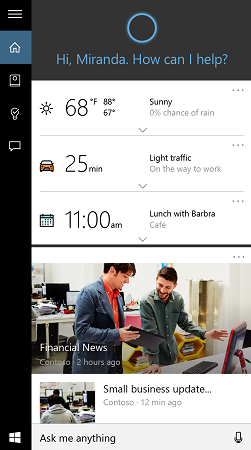

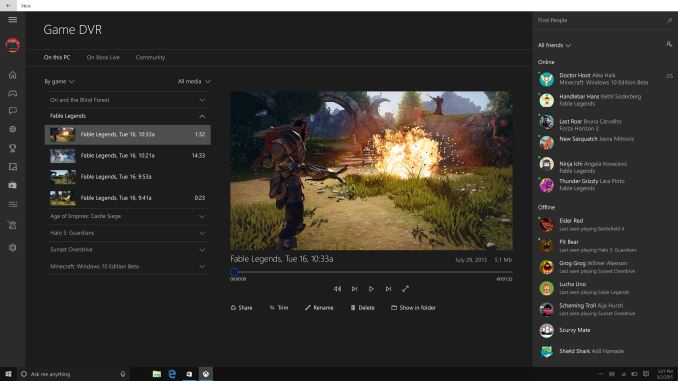


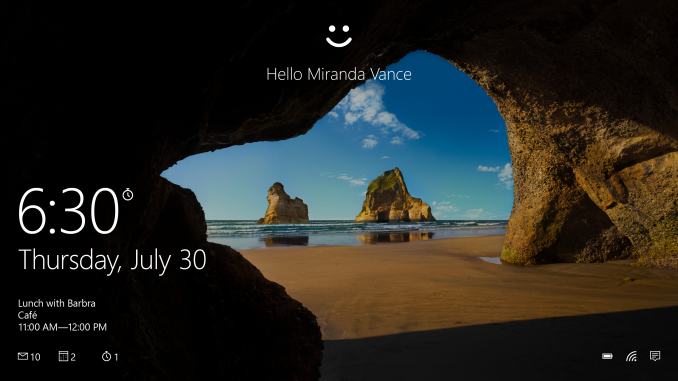








99 Comments
View All Comments
ruthan - Wednesday, July 29, 2015 - link
Im curios, how exactly licence upgrade works - i have retail Win7, could i clone this partition upgrade and use Win7 a Win10 in dualboot or Win7 licence a install possibility will be after upgrade lost, or dual boot with 1 licence is nolegal / disabled etc?jeffkibuule - Wednesday, July 29, 2015 - link
Activation is tied to hardware. You can dual partition on the same machine, you cannot move that Windows 7 license to a different machine. Microsoft is giving you a free upgrade to Windows 10, not a free copy.ruthan - Friday, July 31, 2015 - link
So my retail Win7 license would be crippled to Win 10 OEM?7amood - Wednesday, July 29, 2015 - link
I can see it is still an updated version of Windows Vista... PROFIT!!!!1Xenonite - Wednesday, July 29, 2015 - link
How come nobody seems to be concerned about the performance impact of all of these "features" on a high-performance gaming pc?Is there a way of killing potentially resource consumeing things like the gaming DVR, AERO DWM, Cortana and (especially) live internet information aggregation?
If not, what will the gaming impact of these constant CPU intereupts, to poll the internet, be on the 99th percentile frametimes for games that are not written for DirectX12?
Duraz0rz - Wednesday, July 29, 2015 - link
For the record, my gaming rig has an i5-3570K OCed to ~4Ghz, 8GB RAM, GTX 970, 512GB Crucial MX100 SSD.I've been using the Windows 10 preview since the first build and I've never had any performance degradation from the new features save for the Game DVR. It does not record in the background by default, though, so you won't see any impact until you turn it on manually.
As far as Aero DWM, I've never disabled it before in Windows 7 mainly because I've never noticed any performance impact.
I have Cortana enabled (but not the voice activation) and haven't noticed any performance impact on my machine or latency. You can disable Cortana if you don't want to use it.
I say just give it a shot and see if you find any performance impacts in the games you play. I don't really notice it, but I only really play FFXIV nowadays, with the occasional CS:GO and TF2 game here and there.
Mushkins - Wednesday, July 29, 2015 - link
If your system aggregating weather information in the background is saturating your bandwidth, you need to ditch your 8 baud modem and join us in 2015. Nobody's concerned about this performance hit because it's nonexistent. Do you also disable your system clock from syncing with an internet source because it takes precious resources?Notmyusualid - Wednesday, July 29, 2015 - link
I think he has a very valid point.Less OS is more for gaming. Same for network dependencies too, less processes opening unecessary sockets is also detrimental - when we are chasing milliseconds.
I did see a program that stripped Win 10 down to nothing, and made it very fast, weather, cortana, sports - all that junk out in one double-click. Unfortunately it stiripped-out the Start / Search function too, so the only progs I could access were those that were left on Desktop to 'double-click' from there. When I see this thing again (who's name I've forgotten), I'll upgrade my gaming machine to 10.
royalcrown - Wednesday, July 29, 2015 - link
Well then the problem is that his machine would be lower end or borderline for the recomended specs for windows 10 anyhow and he should probably stick to XP or 7. On any high end machine, the extra .5% cpu usage isn't going to make a big difference in performance unless you're only getting 2 FPS anyhow. That and direct X 12 gameswill more than offset any extra usage most likely. If it performs even a third as good as they hope it will be a big improvement over what we have now.Xenonite - Thursday, July 30, 2015 - link
Not exactly. I am simply very sensitive to frame time variances (which is why I dial down the in-game settings to allow for a relatively constant 140fps on my 144Hz Asus ROG Swift monitor. Sub-100fps framerates, even with G-Sync, are just too juddery and give me extreme motion sickness and nausia), so even though it may only use a fraction of a percent of processing power, a 1ms interrupt service routine would result in the next frame being delayed by 14%, which is quite visible and extremely annoying.